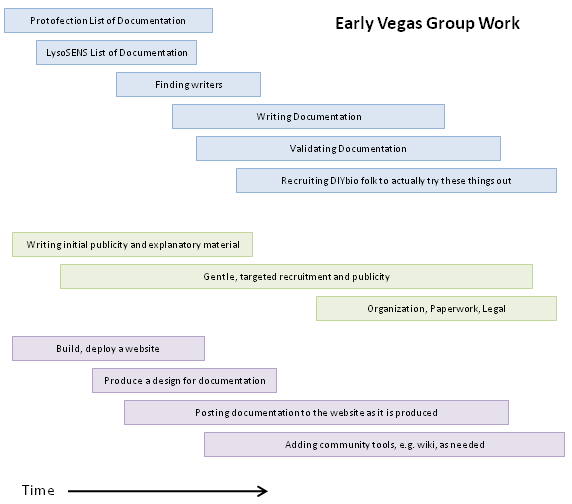An Update on Early Vegas Group Discussions
UPDATE 05/21/2011: The Vegas Group initiative has been renamed to Open Cures, with a new website and a new mailing list. Please do drop by and take a look at what we're working on.
The Vegas Group is a recently launched initiative that aims to speed up translation of existing longevity-enhancing biotechnologies from the laboratory to human therapies. There is little incentive for commercial entities to work on these technologies in the US because the FDA does not recognize aging as a disease, and will therefore never approve a therapy for aging. But if these technologies, currently documented only in the prickly, dense scientific literature, can be brought into the open biotechnology arena, explained, and made accessible, they will be picked up by semi-professionals, developers, and commercial ventures in less restricted parts of the world.
Protofection, for example, is a technique for introducing replacement mitochondrial DNA into all the cells of the body - a way to repair the contribution to aging caused by accumulated defects in mitochondrial DNA. This was demonstrated in mice back in 2005, but the research group responsible has since been working on the commercialization of other aspects of this work. Protofection as a way to repair a fundamental part of the damage of aging will likely languish undeveloped in the US for years to come under the present regulatory regime.
Yet this is an era of medical tourism and near-free transmission of information - if we take currently esoteric but largely proven biotechnology and produce good, free, open instruction manuals, then this knowledge and its application will spread. We can all help to take advantage of the information age and biotechnology revolution that we are living through, and we can start to do this by engaging and persuading the growing open biotechnology and DIYbio community to pay more attention to longevity science.
The Vegas Group is presently a discussion list of a few active volunteers and a small crowd of interested folk. We are looking at the nuts and bolts of organization, focused on a proof of concept documentation project: take mitochondrial protofection and document it sufficiently well to make it accessible to the DIYbio community of enthusiasts and moonlighting biotech professionals who are building open-access devices and establishing shared laboratories. Along the way this means finding freelance life science writers, evangelizing the concept, proofing copy, making diagrams and layouts, and putting up a website - amongst other line items.
Here's a diagram of the early efforts that lie ahead, as I see them:

If you take a look at the discussion list, you'll see some of the following threads underway:
- Discussing the details of protofection, and how to proceed with documenting the procedures involved
- A roving discussion on to-do lists, graphics, and layout
- A list of online resources to learn about the DIYbio community
We are looking for more life science and DIYbio volunteers, writers and editors, folk with connections that will help move things along, people with an understanding of the legalities of reverse engineering and intellectual property, and web developers who can help with the forthcoming website. Amongst others - if you think you can help make the Vegas Group a reality, then you probably can. So join the list and help!
Has anyone actually contacted the FDA and asked them WHY they refuse to recognize aging as a disease and would they be willing to change this stance? Does the FDA have a specifically stated policy of refusing to classify aging as a disease? Or is this just bureaucratic inertia in action?
@Abelard Lindsey: As I understand it, this is tied in with definitions and biomarkers. The FDA process for defining a disease is massively detailed and bureaucratic, requiring a very formal and detailed end result, to be agreed upon by a large number of researchers. For example, sarcopenia is not yet classified as a disease, and this is largely a definitional issue. See:
https://www.fightaging.org/archives/2010/10/a-review-of-sarcopenia-research.php
https://www.fightaging.org/archives/2009/07/sage-crossroads-podcasts-on-the-pharmaceutical-industry-and-aging.php
Now sarcopenia is very narrow compared to aging, and yet it has been a decade without approval, and it will take years more and millions of dollars and the detailed biological analysis work from many labs to produce the necessary materials and grudging approval of its status from the FDA. No-one has to resources to waste to do that for aging as a whole, and the FDA would likely laugh any attempt out of the docket - the entire process is so structured so as to make it infeasible to do what would be required to call aging a disease if playing by the established rules. So the whole dark joke continues along.
You answered my question. Its a bureaucratic inertia problem. I'm surprised that sarcopenia is not considered a disease. Bone loss is considered a disease with recognized bio-markers. Coming up with biomarkers for sarcopenia should be no more difficult than those of bone-loss.
I agree that bureaucracy is the root of the problem. I also agree that the FDA should be abolished.
Do you know if anywhere in the OECD/west allows commercial development of aging therapies? Because it seems like only developing countries allow it, simply because they haven't gotten round to growing their departments and agencies to the point of strictly regulating health products for 'safety purposes' - and eventually they will.
FDA is right. Aging is not a disease. It is programmed. Probably to diversify the genetics by removing some carriers out of the pool.